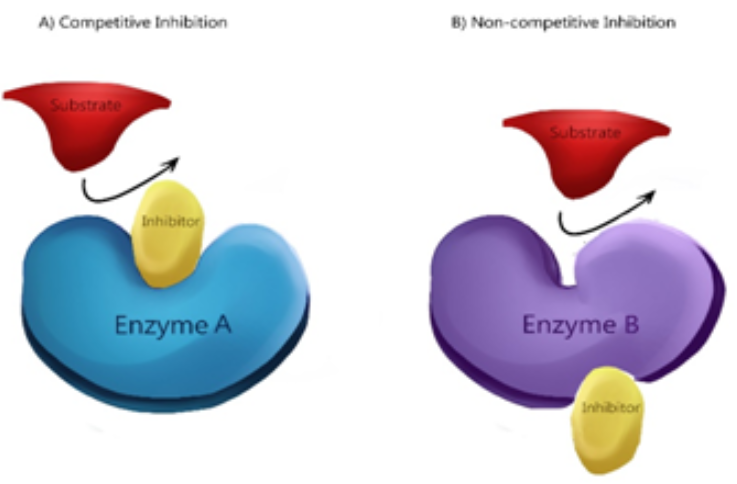
Answer
438.9k+ views
Hint: Competitive inhibition is defined as the process by which one chemical substance inhibits the effect of another one by competing against it for the binding site. Enzyme inhibition is an example of competitive inhibition.
Complete answer: Competitive inhibition happens when the substrate and the inhibitor compete for the same active site. Here, the enzyme and the inhibitor have a similar structure. Thus, the inhibitor can get attached to the active site and inhibits the formation of the product. Active site only allows either the substrate or the inhibitor to bind to the enzyme. Increasing the concentration of the substrate molecule makes the chances of the substrate binding to the active site rather than the inhibitor.

Considering other options:
Non-competitive enzyme inhibition occurs when the inhibitor binds to a different site of an enzyme,
but unlike competitive inhibition is not affected by increasing the substrate concentration. In a competitive inhibition process, the substrate and the inhibitor are competing for the active site on the enzyme unlike competing for an inhibitor protein. Non- competitive inhibition is a reversible process, where a rapid dissociation of the enzyme-inhibitor complex. This process can be inhibited by increasing the concentration of substrate.
Thus, the correct answer is options C.
Note: Enzymes catalyze or change the rate of a reaction, i.e. they either decrease or increase the rate of a reaction. To maintain the optimum concentration, enzyme inhibition is very much required. The different types of enzyme inhibition are competitive, non-competitive and allosteric inhibition.
Complete answer: Competitive inhibition happens when the substrate and the inhibitor compete for the same active site. Here, the enzyme and the inhibitor have a similar structure. Thus, the inhibitor can get attached to the active site and inhibits the formation of the product. Active site only allows either the substrate or the inhibitor to bind to the enzyme. Increasing the concentration of the substrate molecule makes the chances of the substrate binding to the active site rather than the inhibitor.

Considering other options:
Non-competitive enzyme inhibition occurs when the inhibitor binds to a different site of an enzyme,
but unlike competitive inhibition is not affected by increasing the substrate concentration. In a competitive inhibition process, the substrate and the inhibitor are competing for the active site on the enzyme unlike competing for an inhibitor protein. Non- competitive inhibition is a reversible process, where a rapid dissociation of the enzyme-inhibitor complex. This process can be inhibited by increasing the concentration of substrate.
Thus, the correct answer is options C.
Note: Enzymes catalyze or change the rate of a reaction, i.e. they either decrease or increase the rate of a reaction. To maintain the optimum concentration, enzyme inhibition is very much required. The different types of enzyme inhibition are competitive, non-competitive and allosteric inhibition.
Recently Updated Pages
Who among the following was the religious guru of class 7 social science CBSE

what is the correct chronological order of the following class 10 social science CBSE

Which of the following was not the actual cause for class 10 social science CBSE

Which of the following statements is not correct A class 10 social science CBSE

Which of the following leaders was not present in the class 10 social science CBSE

Garampani Sanctuary is located at A Diphu Assam B Gangtok class 10 social science CBSE

Trending doubts
A rainbow has circular shape because A The earth is class 11 physics CBSE

Which are the Top 10 Largest Countries of the World?

Fill the blanks with the suitable prepositions 1 The class 9 english CBSE

The Equation xxx + 2 is Satisfied when x is Equal to Class 10 Maths

How do you graph the function fx 4x class 9 maths CBSE

Give 10 examples for herbs , shrubs , climbers , creepers

Who gave the slogan Jai Hind ALal Bahadur Shastri BJawaharlal class 11 social science CBSE

Difference between Prokaryotic cell and Eukaryotic class 11 biology CBSE

Why is there a time difference of about 5 hours between class 10 social science CBSE




